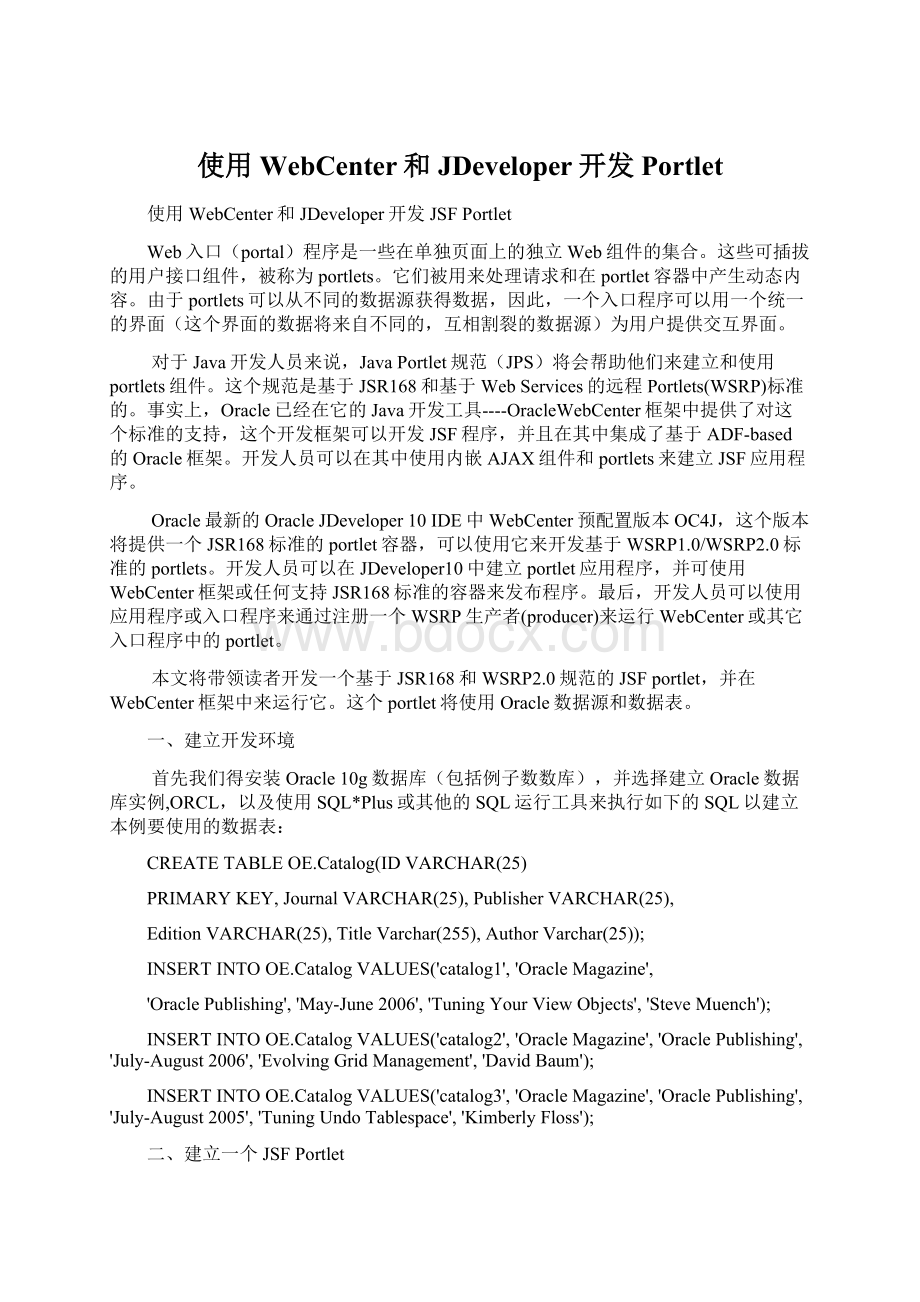使用WebCenter和JDeveloper开发PortletWord文档下载推荐.docx
《使用WebCenter和JDeveloper开发PortletWord文档下载推荐.docx》由会员分享,可在线阅读,更多相关《使用WebCenter和JDeveloper开发PortletWord文档下载推荐.docx(14页珍藏版)》请在冰豆网上搜索。

EvolvingGridManagement'
DavidBaum'
catalog3'
July-August2005'
TuningUndoTablespace'
KimberlyFloss'
二、建立一个JSFPortlet
在这部分,我们将使用Oracle数据库作为数据源建立一个JSF应用程序,然后将这个JSF程序转换为portlet。
这个JSF应用程序由一个使用SQL查询动态产生的DataTable组成。
首先,在JDeveloper中选择File->
New建立一个JDeveloper工程,然后使用在NewGallerywizard中的General->
Application。
指定一个工程名后,选择WebCenter应用程序作为应用程序模板。
在建立完WebCenter工程后,所有的数据和资源都会在如图1的ApplicationsNavigator中显示出来。
这个应用程序由用于建立portlet的Portlets工程和用于建立JSF视图页的ViewController工程组成,portlets可以在这个工程中被嵌入。
图1.WebCenter工程效果图
在这里我们将使用WebCenter框架中的JSF-Portlet桥来编写JSF应用程序,这就意味着JSF应用程序将是基于JSR168portlets的。
我们可以选择Tools->
Project项来加入JSF-Portlet桥所需的库。
我们还需要加入ADFFaces运行时库和OracleJDBC库。
接下来,我们将使用如下的步骤在WebCenter框架中实现和发布JSF应用程序:
1.在"
ApplicationsNavigator"
中选择Portlets工程,并选择File->
New
2.在新Gallery模板中,选择Categories中的WebTier->
JSF,然后选择JSFJSP项,单击OK。
3.当JSFJSP模板启动后,单击Next,选择J2EE1.4作为Web应用程序的版本,然后再次单击Next。
4.指定input.jsp作为文件名后,单击Next。
5.在一个新的管制Bean中选择AutomaticallyExposeUIComponents,并指定PortletBean作为类名,然后单击Next。
6.选择默认的tag库,JSFCore1.0和JSFHTML1.0,然后单击Next。
7.选择默认的HTML选择,然后单击Next。
8.单击Finish按钮后,在Portlets工程中建立一个JSF页(也就是input.jsp)和一个faces-config.xml发布文件。
下面我们来建立一个portlet。
一个portlet需要一个portlet.xml文件,因此,我们按如下步骤在Portlets工程中加入一个portlet.xml文件。
1.选择File->
2.在NewGallerywizard中,从Catagories菜单中选择FilterBy->
AllTechnologiesandselectGeneral->
DeploymentDescriptors
3.选择portlet.xml,并单击OK
图2显示了我们的JSFportlet应用程序的目录结构。
图2JSFPortlet应用程序的目录结构
现在,我们准备在应用程序中加入JSF组件。
在ComponentPalette中,选择JSFHTML,并将以下内容加入到input.jsp页中:
1.一个输出标签
2.一个输入文本字段
3.一个命令按钮
4.一个数据表
在JSF页中的文本字段指定一个SQL查询。
当一个用户单击建立数据表命令时,PortletBean.java类中的commandButton_action方法被调用,然后一个数据表被动态地创建。
PortletBean.java中的部分代码如下:
packageportlet.backing;
......
publicclassPortletBean{
........
publicStringcommandButton_action(){
ResultSetrs=null;
try{
InitialContextinitialContext=newInitialContext();
javax.sql.DataSourceds=
(javax.sql.DataSource)initialContext.lookup("
java:
comp/env/jdbc/OracleDBConnectionDS"
java.sql.Connectionconnection=ds.getConnection();
Statementstmt=
connection.createStatement(ResultSet.TYPE_SCROLL_INSENSITIVE,
ResultSet.CONCUR_READ_ONLY);
rs=stmt.executeQuery((String)inputText1.getValue());
dataTable1.setBorder(5);
dataTable1.setCellpadding("
1"
dataTable1.setVar("
catalog"
HtmlOutputTextheaderComponent1=newHtmlOutputText();
headerComponent1.setId("
headerComponent1"
headerComponent1.setValue("
CatalogId"
column1.setHeader(headerComponent1);
HtmlOutputTextheaderComponent2=newHtmlOutputText();
headerComponent2.setId("
headerComponent2"
headerComponent2.setValue("
Journal"
column2.setHeader(headerComponent2);
HtmlOutputTextheaderComponent3=newHtmlOutputText();
headerComponent3.setId("
headerComponent3"
headerComponent3.setValue("
Publisher"
column3.setHeader(headerComponent3);
HtmlOutputTextheaderComponent4=newHtmlOutputText();
headerComponent4.setId("
headerComponent4"
headerComponent4.setValue("
Edition"
column4.setHeader(headerComponent4);
HtmlOutputTextheaderComponent5=newHtmlOutputText();
headerComponent5.setId("
headerComponent5"
headerComponent5.setValue("
Title"
column5.setHeader(headerComponent5);
HtmlOutputTextheaderComponent6=newHtmlOutputText();
headerComponent6.setId("
headerComponent6"
headerComponent6.setValue("
Author"
column6.setHeader(headerComponent6);
HtmlOutputTextcolumn1Text=newHtmlOutputText();
column1Text.setId("
htmlOutputText1"
ValueBindingvb=
FacesContext.getCurrentInstance().getApplication().createValueBinding("
#{catalog.ID}"
column1Text.setValueBinding("
value"
vb);
column1.getChildren().add(column1Text);
HtmlOutputTextcolumn2Text=newHtmlOutputText();
column2Text.setId("
htmlOutputText2"
vb=
#{catalog.JOURNAL}"
column2Text.setValueBinding("
column2.getChildren().add(column2Text);
HtmlOutputTextcolumn3Text=newHtmlOutputText();
column3Text.setId("
htmlOutputText3"
#{catalog.PUBLISHER}"
column3Text.setValueBinding("
column3.getChildren().add(column3Text);
HtmlOutputTextcolumn4Text=newHtmlOutputText();
column4Text.setId("
htmlOutputText4"
#{catalog.EDITION}"
column4Text.setValueBinding("
column4.getChildren().add(column4Text);
HtmlOutputTextcolumn5Text=newHtmlOutputText();
column5Text.setId("
htmlOutputText5"
#{catalog.TITLE}"
column5Text.setValueBinding("
column5.getChildren().add(column5Text);
HtmlOutputTextcolumn6Text=newHtmlOutputText();
column6Text.setId("
htmlOutputText6"
vb=FacesContext.getCurrentInstance().getApplication().createValueBinding("
#{catalog.AUTHOR}"
column6Text.setValueBinding("
column6.getChildren().add(column6Text);
ResultSetDataModeldataModel=newResultSetDataModel();
dataModel.setWrappedData(rs);
dataTable1.setValue(dataModel);
}catch(SQLExceptione){
System.out.println(e.getMessage());
}catch(javax.naming.NamingExceptione){
}
returnnull;
}
在输入文本框中被指定的SQL查询在commandButton_action方法中运行,并为数据表产生一个结果集。
下面将显示input.jsp的全部代码:
<
%@pagecontentType="
text/html;
charset=windows-1252"
%>
%@tagliburi="
prefix="
f"
h"
f:
view>
<
h:
formid="
form1"
>
outputLabelvalue="
SQL"
binding="
#{backing_input.outputLabel1}"
id="
outputLabel1"
/>
inputTextid="
inputText1"
#{backing_input.inputText1}"
commandButtonid="
commandButton1"
value="
CreateDataTable"
#{backing_mandButton1}"
action="
#{backing_mandButton_action}"
dataTableid="
dataTable1"
rows="
5"
#{backing_input.dataTable1}"
columnid="
column1"
#{backing_input.column1}"
column2"
#{backing_input.column2}"
column3"
#{backing_input.column3}"
column4"
#{backing_input.column4}"
column5"
#{backing_input.column5}"
column6"
#{backing_input.column6}"
/h:
dataTable>
form>
/f:
接下来我们应为每一个动态JSP组件指定一个ID。
如果我们不这么做,JSF框架将在portlet标记中产生重复的ID,当portlet运行时会产生以下错误:
DuplicatecomponentID…foundinview.
AninternalerrorhasoccurredinmethodgetMarkup()
编辑web.xml和portlet.xml文件,在web.xml中加入以下context-param结点:
context-param>
param-name>
javax.faces.application.CONFIG_FILES<
/param-name>
param-value>
/WEB-INF/faces-config.xml,/WEB-INF/portlet.xml<
/param-value>
/context-param>
javax.faces.STATE_SAVING_METHOD<
server<
在web.xml中加入以下ADFFacesfilter过滤器:
filter>
filter-name>
adfFaces<
/filter-name>
filter-class>
oracle.adf.view.faces.webapp.AdfFacesFilter<
/filter-class>
/filter>
按着如下步骤编辑portlet.xml文件:
1.使用<
portlet>
/portlet>
结点指定一个portlet。
2.指定一个portlet类oracle.portlet.server.bridges.jsf.FacesPortlet
3.为默认页指定一个结点<
init-param/>
,当portlet运行时这个页被显示。
代码如下:
init-param>
name>
DefaultPage.view<
/name>
value>
/input.jsp<
/value>
/init-param>
4.为BridgeLifecycleListenerslistener类指定一个<
结点,代码如下:
BridgeLifecycleListeners<
oracle.portlet.server.bridges.jsf.adf.ADFFacesBridgeLifecycleListener
下面将显示portlet.xml文件的完整内容:
?
xmlversion="
1.0"
encoding="
UTF-8"
standalone="
yes"
portlet-appversion="
xsi:
schemaLocation="
xmlns:
xsi="
http:
//www.w3.org/2001/XMLSchema-instance"
xmlns="
portlet-name>
DataTablePortlet<
/portlet-name>
display-name>
DataTablePortlet<
/display-name>
portlet-class>
oracle.portlet.server.bridges.jsf.FacesPortlet<
/portlet-class>
oracle.portlet.server.bridges.jsf.adf.ADFFacesBridgeLifecycleListener
supports>
mime-type>
text/html<
/mime-type>
portlet-mode>
VIEW<
/portlet-mode>
/supports>
sup